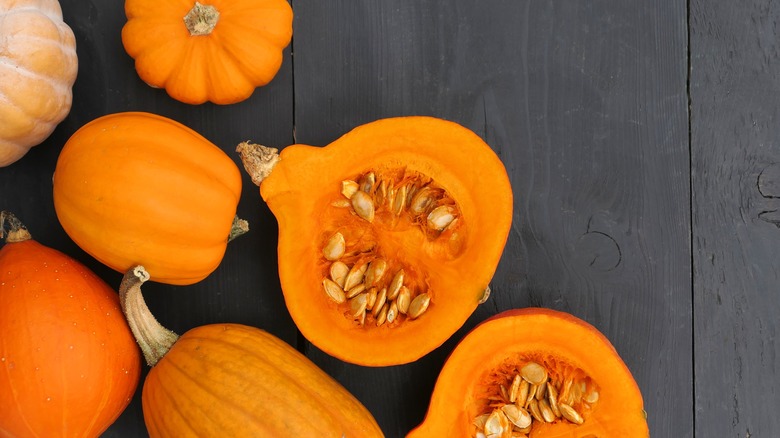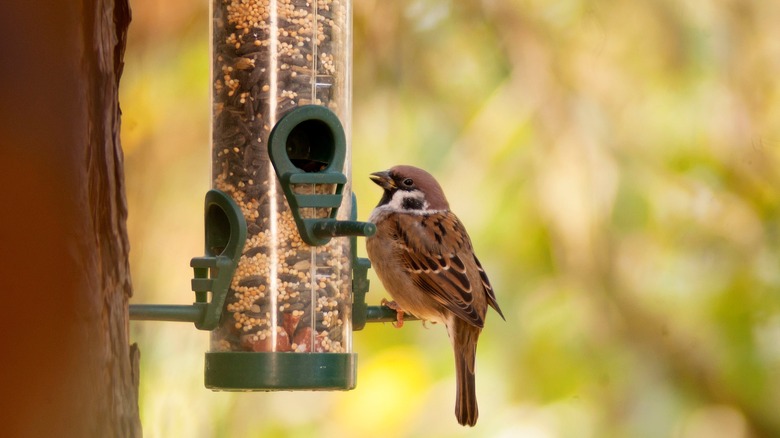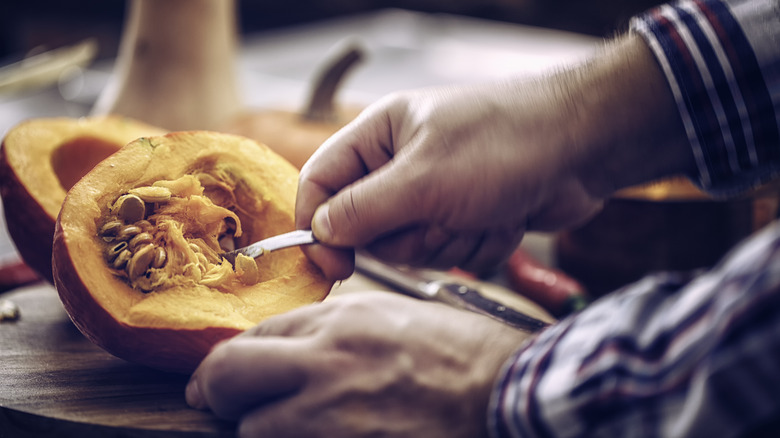If You Have A Bird Feeder, You'll Want To Hold Onto Your Pumpkin Seeds This Fall
Fall is almost here, so it's time to redirect your attention away from your summer garden and toward your fall plants. If you're like us, and a true lover of fall, chances are you've already geared up to plant some pumpkins. Pumpkins (and their tasty seeds) are just as useful in your garden as in your kitchen. If you need something to fill a bird feeder, look no further than pumpkin seeds.
Pumpkins are a great addition to any fall garden because they are so versatile. You can make soups, pies, salads, you name it, out of them. You can carve them as jack-o-lanterns and even roast the seeds for a special treat for yourself or a couple of birds. Birds don't like their pumpkin seeds exactly like we do, though.
To get the most out of your autumnal harvest and make the most of your bird feeder, you need to know a thing or two about the birds in your area and how to prepare the seeds just right. If utilized correctly, there are a few surefire ways to incorporate pumpkin seeds into your feeders that will keep your birds full and happy throughout the fall and beyond.
Learn the basics
First things first, there are only a few kinds of backyard birds that can safely ingest pumpkin seeds. The range of birds living in the suburban U.S. has a varied and expansive diet. Some, like robbins, gravitate towards heavy nuts and grubs — things that can be foraged from the ground — and stay away from bird feeders altogether.
While not all birds enjoy pumpkin seeds or bird feeders, most will at least try them, and some will love them. Common birds that gravitate towards the seeds include blue jays, European starlings, Northern doves, purple finches, and rose-breasted grosbeaks, to name a few. Even fruit-eating birds like the American Oriole have been known to snack on a seed occasionally as long as it still has some meat attached. An added bonus? Ducks love them. Chances are you don't have ducks in your yard, but you can always make a trip to your local pond and make a duck's day.
Once you've deduced what birds live in your area, double-check that you have the right kind of bird feeder. A simple hopper feeder will usually do the trick for most kinds of feed, including pumpkin seeds. The key is ensuring the lats are big enough to allow the seeds to pass through easily. If your feeder won't accommodate larger seeds and you aren't particularly interested in buying a new one, a clean tray left on a windowsill will do in a pinch.
Prepare the pumpkin seeds
Kids look forward to carving pumpkins and roasting their seeds for a salty treat every Halloween. Birds, on the other hand, while big fans of the seeds, can't ingest the same way you and your kids can. As with many things in nature, when it comes to feeding birds, going natural is best. Simply scoop the seeds directly from the pumpkin — wash them off if they're too gooey — and toss them in your bird feeder or onto your feeding tray.
Throwing away any leftover pumpkin seeds you make for yourself or your family in your bird feeder might be tempting, but resist the urge. Roasted pumpkin seeds recipes often call for salt, pepper, cumin, and other tasty seasonings, but these can wreak havoc on your yard. Not only will some of the more flavorful blends scare off your feathered friends, but they'll also attract visitors you do not want, like rats and mice.
If you do find yourself with a rodent problem, switching up your feeder for one with a lid and plastic panels and making sure you keep the area around the feeder clean can help deter unwanted guests. Another good option is to add something spicy, like bird-safe pepper oil, to your blend. The birds won't notice, and the pests can't stand it. Any seeds you don't want for yourself are for the birds, so do your best to prepare and protect them with that in mind.


